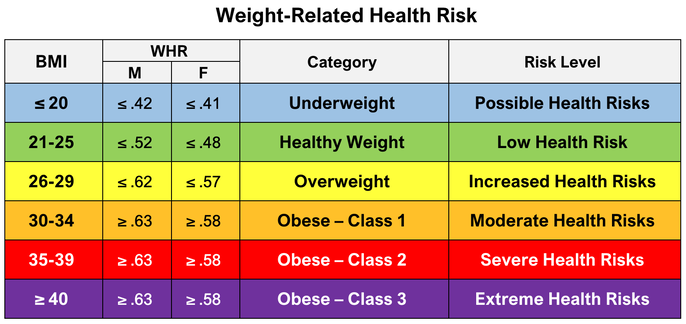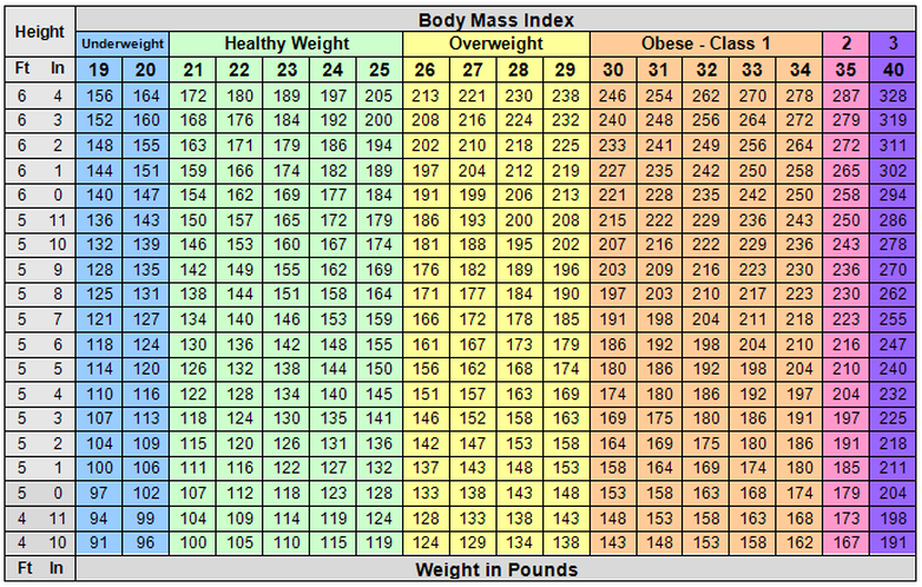Med-Fit Tech Assistant
Medical-Fitness Assessment - Learning Module #6
Anthropometrics
Part C
Part C: Health Risks & Weight Loss
Learning Objectives:
Learning Objectives:
- Accurately determine weight-related health risk
- Accurately determine healthy weight range
- Determine the amount of excess fat weight
- Determine the duration and goal date of a weight loss goal
1. Weight-Related Health Risk
Body Mass Index (BMI) and Waist:Height Ratio (WHtR) are valid measurements of an individual's weight-related health risks when used together in order to distinguish excess weight as either fat or muscle.
Body Mass Index (BMI) and Waist:Height Ratio (WHtR) are valid measurements of an individual's weight-related health risks when used together in order to distinguish excess weight as either fat or muscle.
- BMI's greater than 25 are associated with increasingly severe health risks, including: heart disease, diabetes, hypertension, osteoarthritis, and many forms of cancer, especially colon, breast, and prostate cancers.
- Since BMI is based solely on Height & Weight measurements, and not on body composition (percent body fat, %BF) which is the true predictor of health risk for chronic disease, BMI's are only valid for 75% of the adult population.
- Waist:Height Ratios greater than 0.5 usually validates the weight-related health risks based on the BMI, because it indicates the excess weight is probably due to excess fat rather than muscle.
- Excess abdominal fat (WHtR > 0.5) is an independent risk factor for chronic disease.
- Most of the 25% invalid BMI's indicate a LOW health risk when in fact excess fat weight is "hidden," because the person has an inadequate amount of muscle weight. This condition is known as "skinny-fat," which increases the risk of chronic disease rather than reducing it.
- A small amount of the 25% invalid BMI's indicate an increased risk when in fact the "excess" weight (BMI >25) is due to extra muscle, which reduces the health risk for chronic disease rather than increasing it.
- Fitness Tests are powerful tools to identify which individuals are healthy or unhealthy regardless of body Weight, BMI, or WHtR. Fitness tests will also determine an appropriate training program for unhealthy individuals to increase muscle mass, reduce fat weight, and improve cardiovascular fitness for preventing, or even reversing, chronic disease, reducing health risks, and achieving optimal health.
Health Risk Interpretation
If your client's BMI places him/her in the Healthy Weight category, but their WHtR is in the Overweight or Obese category, their body composition is probably unhealthy with not enough muscle.
If your client's WHtR category matches his/her BMI category, their BMI & WHtR are probably valid weight-related health risk indicators, and you can use the BMI chart to determine a Healthy Weight range specific to their Height and Gender.
If your client's BMI places him/her in the Overweight or Obese category, but their WHtR is in the Healthy Weight or Overweight category, their "excess" weight is probably due to having more muscle than the average person of his/her height and weight - making their BMI invalid as a health risk indicator. In that case, disregard their BMI and use their WHtR alone to determine their weight-related health risk.
If your client's WHtR category matches his/her BMI category, their BMI & WHtR are probably valid weight-related health risk indicators, and you can use the BMI chart to determine a Healthy Weight range specific to their Height and Gender.
If your client's BMI places him/her in the Overweight or Obese category, but their WHtR is in the Healthy Weight or Overweight category, their "excess" weight is probably due to having more muscle than the average person of his/her height and weight - making their BMI invalid as a health risk indicator. In that case, disregard their BMI and use their WHtR alone to determine their weight-related health risk.
2. Healthy Weight Range
A healthy weight range can easily be determined for an average client by using the BMI Chart.
A healthy weight range can easily be determined for an average client by using the BMI Chart.
- Find the Healthy Weight range for the client's height. Example: 5' 8" = 138-164 pounds
- Male clients should be in the mid to upper part of the Healthy Weight range for a BMI of 23-25. Example: 151-164 pounds
- Female clients should be in the mid to lower part of the Healthy Weight range for a BMI of 21-23. Example: 138-151 pounds
- For the client's weight to truly be healthy, it needs to be composed of mostly lean body mass (muscles, bones, organs, and connective tissues), and of less fat.
- Example: Male WHtR < 0.48, Female WHtR < 0.45 or Male %BF = 10-20%, Female %BF = 15-25% (see Part D).
3. Weight Loss Formula's
If your client has been validated as being in the Overweight or Obese category, it is very helpful to spend a little extra time with him/her to explain their situation in more detail and explain their options, because although their fat weight puts them at increased risk for chronic disease, obesity and its related health risks are reversible using clinically proven therapeutic lifestyle therapies that are safe and effective. Most people can lose 0.5 to 1.0 pound per week (2-4 pounds per month) by implementing a simple and gradual nutrition and exercise program that meets their needs and preferences and keeps the weight off.
Use the BMI Chart above and your client's anthropometrics to answer the questions below:
1. For your client's Height and Gender, how much should he/she weigh to have a healthy BMI?
2. How many pounds over their Goal Weight does your client currently weigh?
3. Divide the number of pounds that your client is over their Goal Weight by 2, 3, or 4 (pounds per month to be lost), depending on their motivation level to lose their excess fat weight.
If your client has been validated as being in the Overweight or Obese category, it is very helpful to spend a little extra time with him/her to explain their situation in more detail and explain their options, because although their fat weight puts them at increased risk for chronic disease, obesity and its related health risks are reversible using clinically proven therapeutic lifestyle therapies that are safe and effective. Most people can lose 0.5 to 1.0 pound per week (2-4 pounds per month) by implementing a simple and gradual nutrition and exercise program that meets their needs and preferences and keeps the weight off.
Use the BMI Chart above and your client's anthropometrics to answer the questions below:
1. For your client's Height and Gender, how much should he/she weigh to have a healthy BMI?
- Goal Weight = _____ pounds
2. How many pounds over their Goal Weight does your client currently weigh?
- Current Weight - Goal Weight = Excess Fat Weight: _____ pounds
3. Divide the number of pounds that your client is over their Goal Weight by 2, 3, or 4 (pounds per month to be lost), depending on their motivation level to lose their excess fat weight.
Excess Fat Weight .
---------------------------------- = Duration of Weight Loss Program: _____ months
Weight Loss Rate .
(2,3, or 4 pounds/month) .
---------------------------------- = Duration of Weight Loss Program: _____ months
Weight Loss Rate .
(2,3, or 4 pounds/month) .
4. If your client started his/her weight loss (fitness) program this month, when would they achieve their goal weight (Month/Year)?
Goal Weight:_________ pounds
Weight Loss Rate: - ___ pounds/month
Goal Date = _____/_______
Weight Loss Rate: - ___ pounds/month
Goal Date = _____/_______
Instead of setting a huge, never-before-achieved goal for your client, such as: "You need to lose 50 pounds and then keep it off!" Most people can visualize a reasonable health and fitness program in which they make enough simple (and permanent) lifestyle changes to lose 4 pounds per month for 12 months, and then naturally (almost effortlessly) keep the weight off, because they will have personally developed a healthy lifestyle involving proper nutrition and regular exercise for themselves!

